At 100 feet long and weighing 330,000 pounds, the blue whale is the largest known animal to have ever existed on our planet. This behemoth marine mammal is comparable in size to a space shuttle, which makes it difficult to imagine a creature that could stand against it. But if we look throughout the dawn of time, we can narrow down a list of potential formidable foes. Check out these massive sea monsters that could kill a blue whale!
1. Megalodon

The
Megalodon
is the largest shark ever to live.
©Catmando/Shutterstock.com
The Megalodon is an extinct mackerel shark from 23 million years ago and was once a fearsome predator of the seas. It is the largest shark ever to live, three times the size of a great white. Its teeth were as big as a human hand, and its jaws were so powerful they could tear through the chest cavity of the largest whales at the time, easily puncturing their tough ribs. The largest of its species could reach 60 feet long and weigh up to 50 tons.
2. Mosasaurus
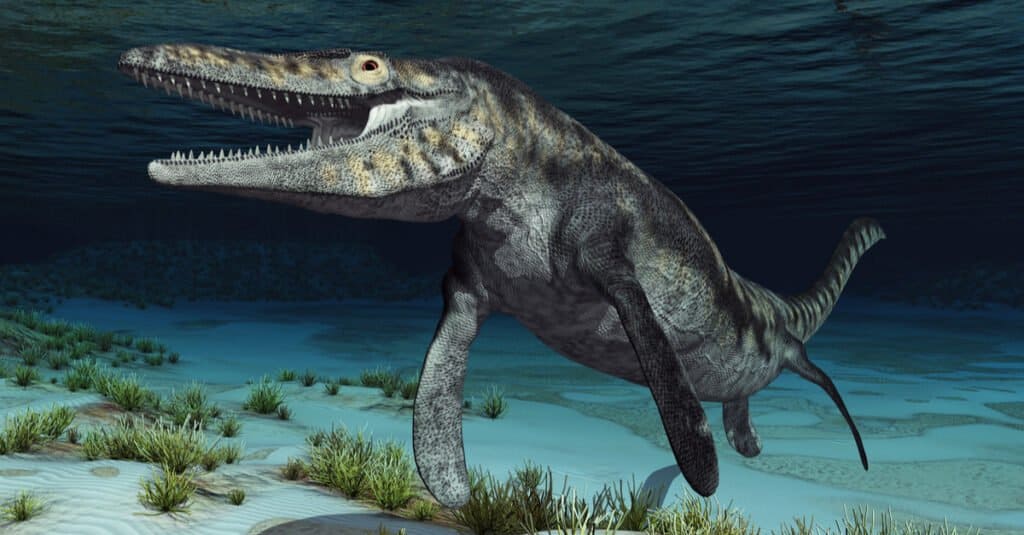
The
Mosasaurus
grew over 50 feet long.
©Michael Rosskothen/Shutterstock.com
This giant aquatic lizard lived 70 million years ago and fed on other sea creatures like sharks and other mosasaurs. Scientists found its fossils in France, South Dakota, and Nebraska, where it would have lived near the surface of the water, breathing air like whales. This carnivorous lizard could grow over 50 feet long and featured a skull with bristling teeth and a long, powerful tail. Researchers once believed they were related to an ancient crocodile, but evidence suggests they were an entirely different species.
3. Livyatan
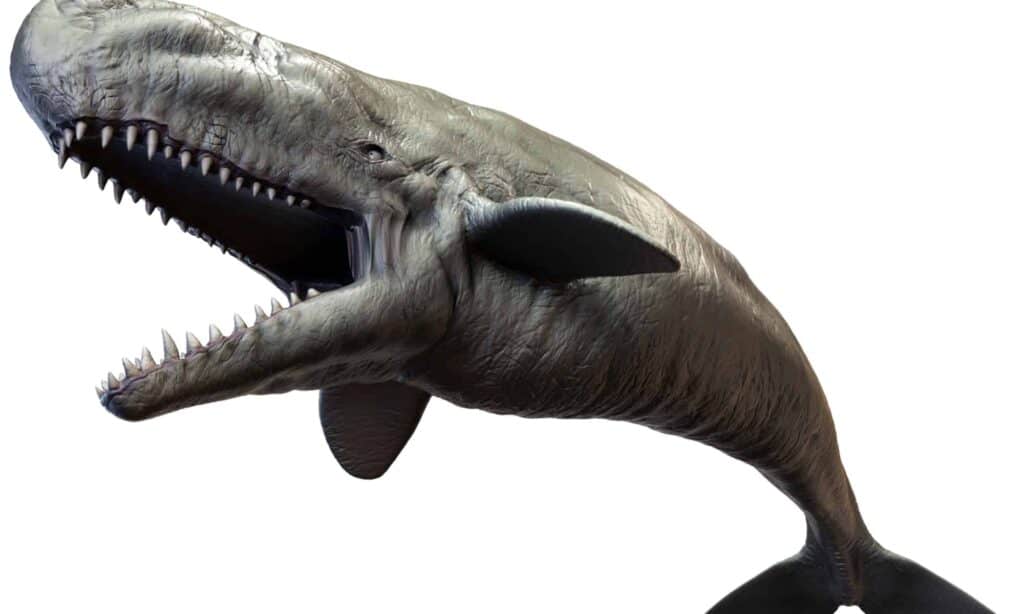
The Livyatan was an
apex predator
who preyed on other whales.
©Herschel Hoffmeyer/Shutterstock.com
Livyatan, meaning “Leviathon” in Hebrew, was a sperm whale from 13 million years ago. It inhabited the southeastern Pacific Ocean near Peru and was an apex predator who preyed on other whales. This beast of a whale was 60 feet long with a 10-foot-long skull, and its teeth were double the size of a T. Rex’s. Its mouth was six feet long and four feet wide, large enough to fit an adult human. This species specialized in preying on giant marine mammals and often succeeded.
4. Ichthyosaur
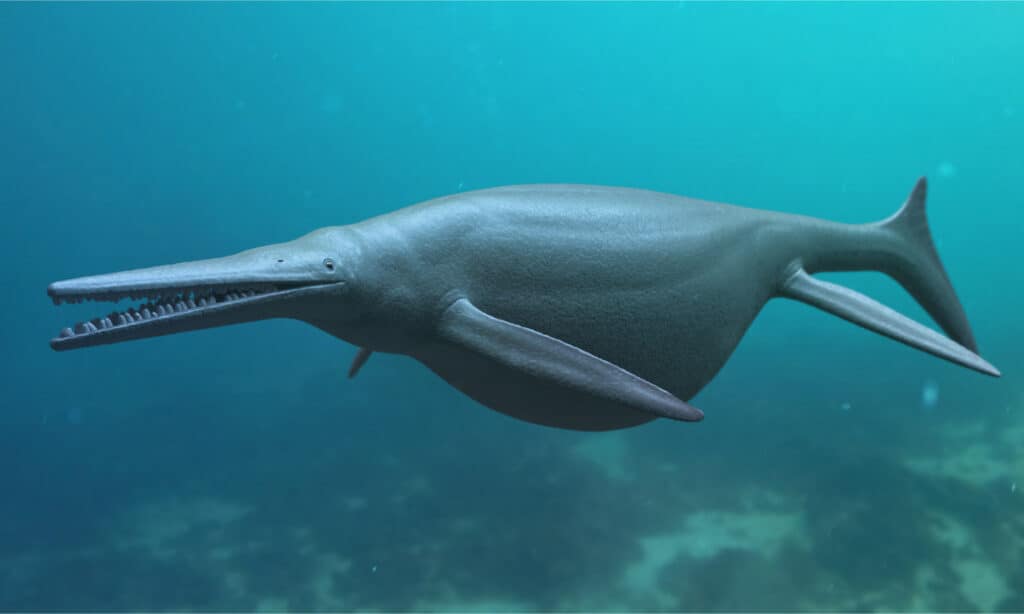
Ichthyosaurus is often compared to a
dolphin
or a shark though it is related to neither species.
©Giant Ichthyosaurus Aquatic Dinosaur 3D Rendered/Shutterstock.com
The Ichthyosaur, or “fish lizard,” was a giant marine reptile from 250 million years ago. They resembled a cross between a fish and a dolphin but had a snout like a crocodile. This creature was one of the top aquatic predators during the Jurassic period and could grow as big as 66 feet. While they mainly hunted smaller animals, they had large bladed teeth that could easily attack something much bigger. These ancient species were fast swimmers and deep divers, moving through the water at 25 mph.
5. Liopleurodon

Liopleurodon had four broad, flat, long flippers that allowed it to thrust itself through the water at considerable speed.
©Michael Rosskothen/Shutterstock.com
The Liopleurodon was a carnivorous marine reptile that ruled the European seas during the late Jurassic period. Uncovered fossils place their length around 22 feet and their weight at 10 tons; they featured elongated heads, short necks, long flippers, and thick torsos. Its skull and jaws took up a significant portion of its overall size and included a powerful bite to take out prey and other predators. They also had an excellent sense of smell and could propel through the water with their flippers, though not as fast as later species.
6. Dunkleosteus

Adult Dunkleosteus had strong jaws that could crush anything, enabling them to attack bigger prey.
©Warpaint/Shutterstock.com
This armored jawed fish was the largest predator during the Devonian era 350 million years ago, when a shallow subtropical sea once covered Ohio. This ancient fish species grew to over 28 feet long and weighed four tons. Its massive skull was made of thick, bony plates, and it had two sets of fang-like structures, which it used to chomp on sharks and other enormous sea creatures. They used suction-feeding to assist in prey capture; their jaws opened within milliseconds and had a high bite force when closing.
7. Kronosaurus
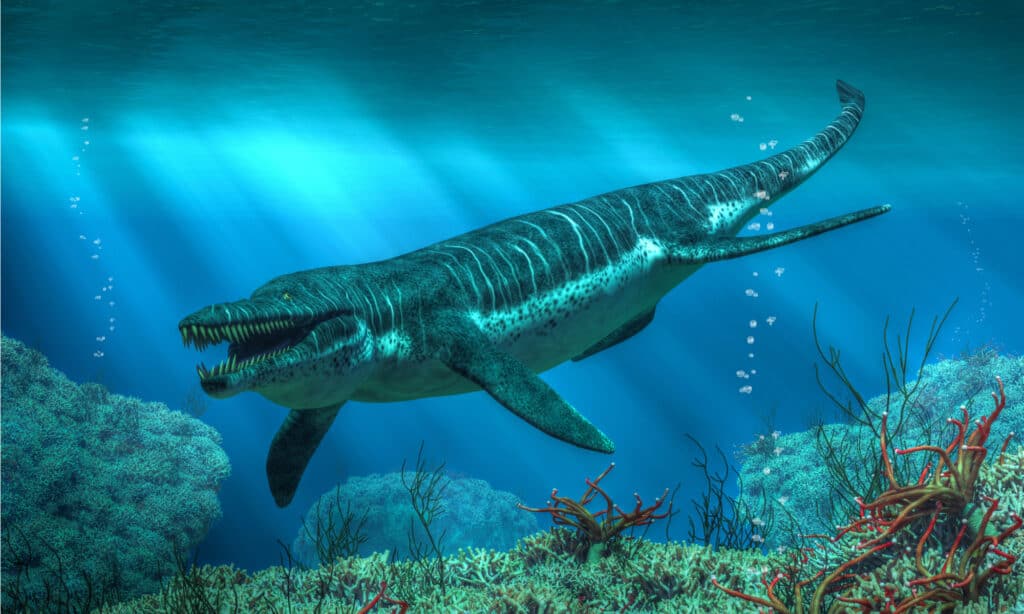
The Kronosaurus would chomp down on animals and tear off chunks.
©Daniel Eskridge/Shutterstock.com
Named after the leaders of the Greek Titans, the Kronosaurus was one of the largest short-necked pliosaurs. Scientists discovered its fossils near Australia, where it was an apex predator during the early Cretaceous period. Their teeth were 30 centimeters long, and they used them to chomp down on animals and forcefully pull chunks of bone and flesh. But despite their size, they typically fed on medium-sized animals that they could coax into their mouths and swallow whole.
8. Basilosaurus
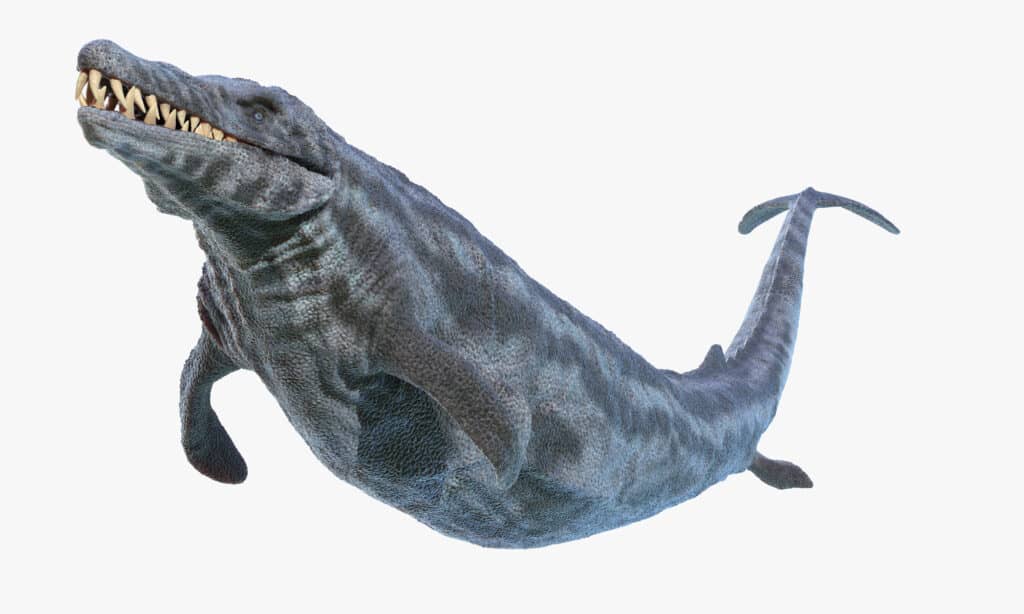
The
Basilosaurus
is one of the largest animals to exist after the dinosaurs.
©SciePro/Shutterstock.com
The Basilosaurus, also known as “king lizard,” was a predatory prehistoric whale that ruled the seas during the late Eocene era after dinosaurs went extinct. Their name implies that they were reptilian, but research confirms they were an early marine mammal. It is one of the largest animals to exist after the dinosaurs, reaching 66 feet long. Rather than swallow prey whole, as many whales do, the Basilosaurus had teeth to chew its meals. Fossil remains confirmed they feasted on sharks and elephants that wandered too close to the water’s edge.
9. Predator X
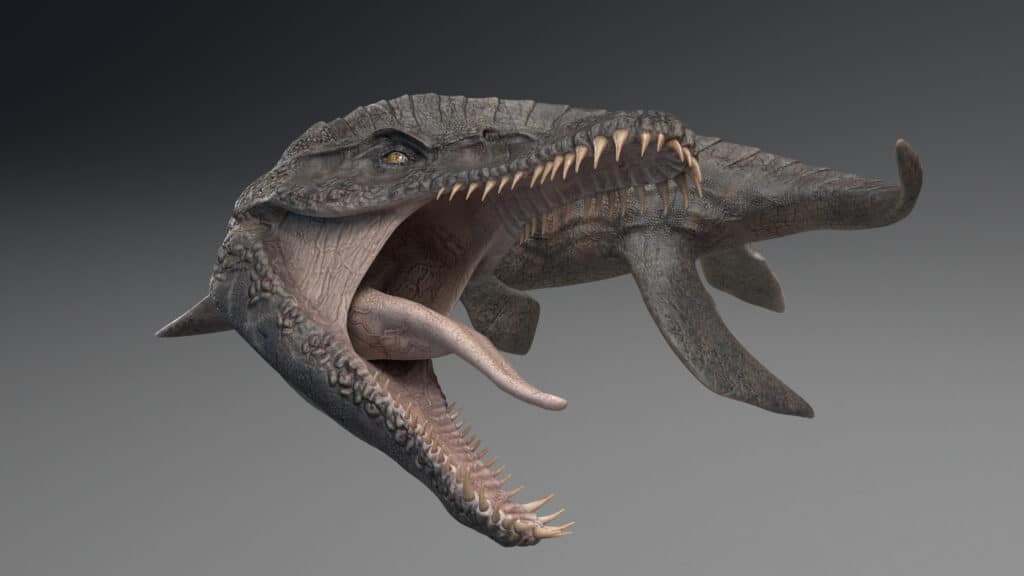
Predator X was a massive apex predator
©Racksuz/Shutterstock.com
The Pliosaurus, or “Predator X,” was a giant lizard-like creature from the late Jurassic period that swam in the seas near Europe and South America. They were some of the largest plesiosaurs of all time and could exceed 33 feet in length and weigh over 11 metric tons. This species had triangular cross-section teeth, a six-foot skull, and a bite strength four times stronger than a T. Rex’s. During this period, giant sea predators reigned, and Predator X was at the top of the food chain.
10. Killer Whale
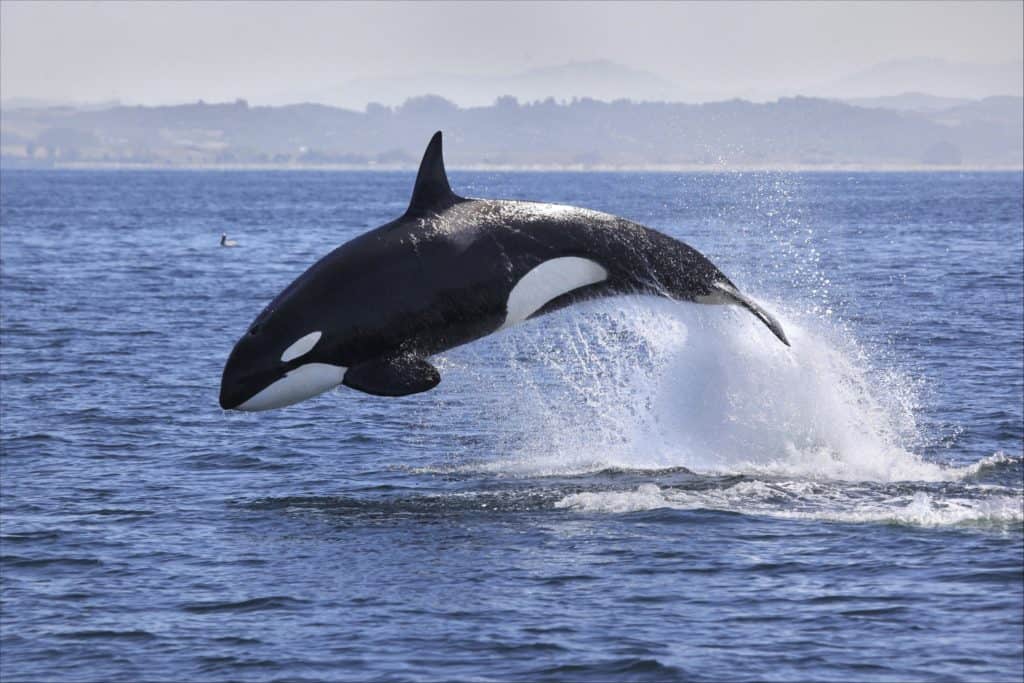
Killer whales
are the only animals in modern times that can hunt and kill blue whales.
©Tory Kallman/Shutterstock.com
In modern times, only one animal is responsible for killing blue whales. The orca, or killer whale, measures 26 feet long and weighs around 8,000 pounds. These creatures may not be bigger than a blue whale, but they work in groups and use coordinated attacks to bring down large prey. People have observed pods of orcas (around 10 to 12) taking down a 70-foot blue whale and eating their fill of the blubbery mammal.
Up Next:
- Meet the Massive Sea Snake that Feasted on Whales (Seriously!)
- River Monsters: Discover the Largest Fish in the Yangtze River
- Meet the 7 Most Famous Dinosaurs From Jurassic Park
The photo featured at the top of this post is © Antonio Viesa/Shutterstock.com
Thank you for reading! Have some feedback for us? Contact the AZ Animals editorial team.






